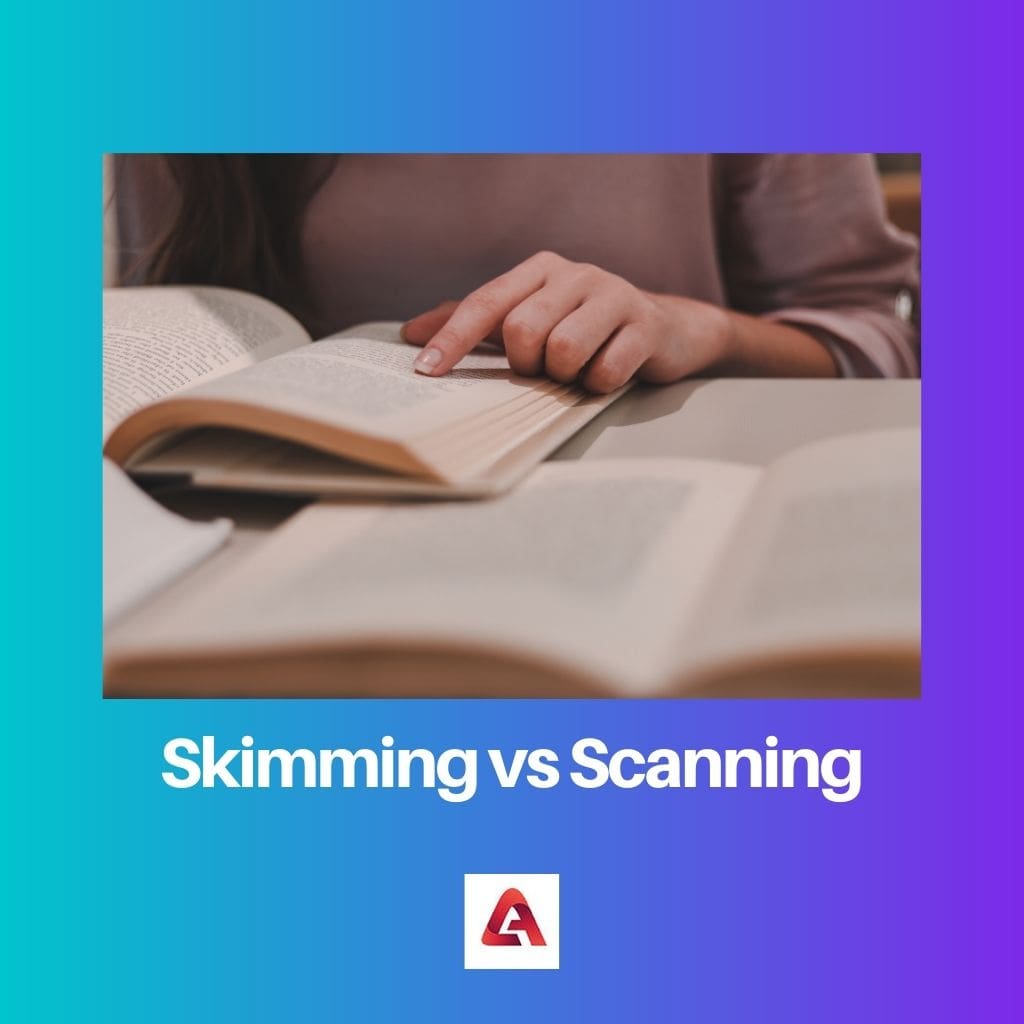Skimming involves quickly glancing over a text to get a general sense of its content, focusing on headings, keywords, and subheadings. It is useful for quickly determining the main ideas. Scanning, on the other hand, is a more targeted search for specific information, involving moving your eyes quickly over the text to locate particular details or keywords without reading the entire content.
Key Takeaways
- Skimming is a reading technique where the reader quickly goes through a text to grasp its main ideas or general overview without focusing on details.
- Scanning is a reading method where the reader searches for specific information within a text, such as keywords, facts, or figures, without reading the entire content.
- Skimming aims to quickly understand the overall content while scanning targets specific details or information within the text.
Skimming vs Scanning
The difference between Skimming and Scanning is that both are reading techniques but used for different purposes. Skimming is reading to get a surface-level understanding of the concept. At the same time, scanning is a reading method used to look for specific information.

Skimming is a fast reading technique to know the text’s plot quickly. With less time, readers can read more text using the skimming process.
Scanning is a reading technique used to look for specific information or a particular word in context. When we want to look for a cricket match score in the newspaper, find a specific name or phone number, the price of your favourite dish on the menu, and so on.
Comparison Table
| Feature | Skimming | Scanning |
|---|---|---|
| Purpose | Get a general overview of the text | Find specific information |
| Focus | Main ideas, gist of the content | Keywords, dates, numbers, facts |
| Reading Speed | Very fast | Extremely fast, may involve jumping around the text |
| Level of Attention | Light | Focused on specific details |
| Prior Knowledge | Not necessarily familiar with the text | May have a good idea of what they’re looking for |
| Outcome | Understand the main topic, arguments, or overall structure | Locate specific details or answer a particular question |
| Analogy | Like getting a birds-eye view of a landscape | Like searching for a specific item in a room |
What is Skimming?
Purpose of Skimming
1. Efficiency in Information Retrieval
Skimming is employed to efficiently sift through large volumes of text, allowing readers to identify key points, main ideas, and relevant details without investing significant time.
2. Pre-Reading Strategy
It serves as a valuable pre-reading strategy, enabling readers to preview a text before engaging in a more in-depth examination. This aids in setting expectations and providing a foundation for better comprehension.
Techniques of Skimming
1. Previewing
Overview:
Before diving into the content, preview the text by examining titles, headings, subheadings, and any highlighted or emphasized text.
Purpose:
Gain an initial understanding of the structure and main topics.
2. Reading the First and Last Paragraphs
Overview:
Read the introductory and concluding paragraphs of a section or chapter.
Purpose:
Capture the main ideas, arguments, or conclusions presented in the text.
3. Examining Graphics and Formatting
Overview:
Pay attention to graphics, charts, and formatting elements such as bold or italicized text.
Purpose:
Quickly gather information presented visually and identify emphasized content.
Advantages of Skimming
1. Time Efficiency
Overview:
Skimming allows readers to save time by quickly identifying the most pertinent information.
Purpose:
Efficient information retrieval, particularly when dealing with voluminous texts.
2. Identification of Main Ideas
Overview:
Skimming helps in pinpointing the central themes and main ideas of a text.
Purpose:
Facilitates a quick grasp of key concepts without delving into details.
Limitations of Skimming
1. Risk of Missing Details
Overview:
Due to its rapid nature, skimming may lead to overlooking important details.
Purpose:
Readers may miss nuances or critical information present in the finer details of the text.
2. Reduced Comprehension in Technical Texts
Overview:
In highly technical or complex texts, skimming may result in a superficial understanding.
Purpose:
Detailed comprehension may require a more thorough reading approach.

What is Scanning?
Types of Scanning
1. Document Scanning
Document scanning refers to the conversion of physical documents into digital formats. This process is essential for archiving, easy retrieval, and efficient document management. Document scanners capture images or text, ensuring that valuable information is preserved electronically.
2. Network Scanning
In the realm of cybersecurity, network scanning is a vital practice to identify potential security risks and vulnerabilities within a computer network. This involves probing network devices and systems to detect open ports, services, and potential entry points for unauthorized access.
3. Medical Scanning
Medical scanning includes various imaging techniques such as X-rays, CT scans, MRI, and ultrasound. These methods allow healthcare professionals to visualize internal structures, identify abnormalities, and diagnose medical conditions accurately.
4. Bar Code Scanning
Bar code scanning is prevalent in retail and logistics. It involves using optical scanners to read barcodes, providing information about products, tracking inventory, and facilitating efficient check-out processes.
Techniques of Scanning
1. Passive Scanning
Passive scanning involves collecting information without actively interacting with the target. In network security, this could include monitoring network traffic passively to identify patterns or potential threats.
2. Active Scanning
Active scanning, on the other hand, involves sending requests to a target to gather specific information actively. In cybersecurity, this might include sending probes to identify open ports or vulnerabilities.
Applications of Scanning
1. Security Audits
Scanning plays a critical role in security audits by identifying potential weaknesses in systems, networks, or applications. This proactive approach helps organizations address vulnerabilities before they can be exploited by malicious actors.
2. Quality Control
In manufacturing and production, scanning is used for quality control. Optical scanners and sensors are employed to inspect products for defects, ensuring that only high-quality items reach the market.
3. Diagnostic Imaging
In the medical field, scanning technologies provide invaluable diagnostic tools. X-rays, CT scans, and MRIs enable healthcare professionals to visualize internal structures and diagnose a wide range of medical conditions.

Main Differences Between Skimming and Scanning
- Purpose:
- Skimming: Quickly reviewing the text to get a general idea or overview of the content.
- Scanning: Searching for specific information or details within the text.
- Reading Speed:
- Skimming: Involves a fast reading speed, focusing on headings, subheadings, and the first and last sentences of paragraphs.
- Scanning: Involves a rapid movement of the eyes to locate particular keywords, phrases, or numbers.
- Depth of Understanding:
- Skimming: Provides a superficial understanding of the main ideas without delving into details.
- Scanning: Requires a more focused approach to extract specific information without necessarily understanding the entire context.
- Techniques Used:
- Skimming: Involves reading headings, subheadings, bold or italicized text, and quickly reviewing introductory and concluding paragraphs.
- Scanning: Involves looking for keywords, numbers, or phrases related to the specific information being sought.
- Context Awareness:
- Skimming: Focuses on grasping the overall context and main themes of the text.
- Scanning: Is context-specific, aiming to locate and extract targeted information.
- Application:
- Skimming: Useful for previewing articles, textbooks, or documents to decide if they are relevant or to quickly grasp the main ideas.
- Scanning: Applied when searching for specific details, such as a date, statistic, or a particular piece of information within a document.
- Reading Pattern:
- Skimming: Typically involves reading horizontally across the page, covering a larger portion of text.
- Scanning: Often involves a more vertical or zig-zag pattern as the eyes move quickly to pinpoint specific details.
- Use of Peripheral Vision:
- Skimming: Relies on peripheral vision to quickly identify key elements and gain an overview.
- Scanning: Makes use of peripheral vision to detect keywords or phrases while rapidly moving through the text.
- Time Investment:
- Skimming: Takes less time compared to reading the entire document but provides a quick understanding.
- Scanning: Can be a time-efficient method when looking for specific information but may require more time than skimming.
- Example:
- Skimming: Reading a newspaper headline and the first sentences of each article to understand the main news.
- Scanning: Looking through an article to find a specific quote or statistic without reading the entire text.

- https://www.jstor.org/stable/395451
- https://journals.sagepub.com/doi/abs/10.1080/10862967209547021
- https://online-journal.unja.ac.id/irje/article/view/4338

This is so fascinating and insightful. I love how the article elaborates on the types of skimming and scanning. Great reference material as well.
Couldn’t agree more. It’s a comprehensive resource for understanding these reading techniques.
This piece is a thorough elucidation of skimming and scanning. Truly beneficial to readers of all demographics.
Agreed. It’s a well-structured and informative guide for cultivating efficient reading skills.
The article effectively covers the core concepts of skimming and scanning. It makes it much clearer now.
I agree. It’s essential to understand these skills for better comprehension of texts.
The article provides a comprehensive understanding of efficient reading techniques. I think it’s a valuable resource for educators and students alike.
Couldn’t agree more. The resource references are a great addition.
Absolutely! It’s particularly enlightening for students looking to improve their comprehension skills.
What an insightful article! A fantastic explanation of skimming and scanning. I’ve learned a lot.
I think this is an extremely valuable article, particularly for students or those who engage in research work. It’s a perfect elucidation of the distinction between skimming and scanning.
Completely agree! Understanding these techniques can greatly enhance reading efficiency.
Interesting article. I’ve always known about skimming and scanning but didn’t know it was this detailed.
Me too! It’s amazing how we take such simple techniques for granted.
The article is precise and informative. I find it to be quite engaging and accessible, serving as an excellent resource for those seeking to enhance their reading skills.
Definitely! I appreciate the clarity and depth with which it explains skimming and scanning.
I echo that sentiment. It’s a very effective breakdown of these techniques.
I appreciate the clear difference between skimming and scanning. It provides a useful guide for effective reading techniques.
Very informative. I think many students could benefit from learning these techniques.
Absolutely! This article is quite enlightening.
The comparison table is very helpful in understanding the different objectives, purposes, and techniques employed in skimming and scanning.
Absolutely! It’s a visually clear way to comprehend the contrast between the two methods.